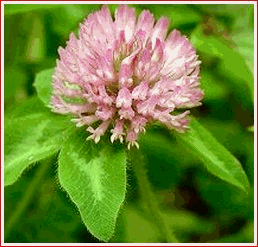
 TRIFOLIUM.
N. F. � RED CLOVER BLOSSOMS
TRIFOLIUM.
N. F. � RED CLOVER BLOSSOMS
United States Dispensatory 1926 (1)
Potters Cyclopedia of Botanic Drugs and
Preparations 1988 (2)
Compiled and edited by Ivor Hughes
(1)
TRIFOLIUM. N. F. TRIFOLIUM Trifol [Red Clover Blossoms]
Trifolium is the dried inflorescence of
Trifolium pratense Linne (Fam. Leguminosae). Trifolium contains not more
than 2 per cent, of foreign organic matter. N.F.
Red Clover, Clover, Trefoil; Trẻfle Rouge, Fr.; Klee, Rothklee, G.; Trifoglio, It.
The clovers are so well known as not to require any extended description. The official species, which is a native of Europe but widely cultivated in the U. S., is characterized by its sessile papilionaceous flowers in dense heads, sweet-scented, and with a purplish corolla which withers after flowering; the stems are ascending and somewhat hairy. The three ovate leaflets are notched at the end and marked on the upper side with a pale spot. The drug comes chiefly from the southern Appalachian district and from Germany.
Description and Physical Properties. � Unground Trifolium.� Heads ovoid with rounded summit, mostly from 12 to 25 mm. in length and width, shriveled, purplish and more or less brown from drying, consisting of many small papilionaceous flowers, crowded together and clothed at the base with broad, pointed ciliate stipules of a pale green color with darker veins, and which may or may not be accompanied by diminutive trifoliate leaves. Flowers from 12 to 15 mm. in length, longer than the four, nearly equal calyx teeth and shorter than the narrower fifth calyx tooth; calyx-teeth, subulate, tapering; petals united into a tube below, the standard longer than the wings but when recurved appearing shorter; stamens diadelphous (nine and one); style slender. Odor faintly aromatic and somewhat tea-like; taste sweetish, then slightly bitter.
Powdered Trifolium. � Brownish red to greenish red; numerous long, sharp-pointed unicellular non-glandular hairs with thick, non-lignified walls, the latter somewhat roughened by slight centrifugal projections; smooth, nearly spheroidal pollen grains from 0.020 to 0.048 mm. in diameter; fragments of epidermis with stomata the latter from 0.013 to 0.023 mm. in length; fragments of corolla tissue composed of closely packed polygonal cells, each cell filled with a rhombohedron of calcium, oxalate, the latter up to 0.017 mm. in length." N. F.
The clover blossoms have been subjected to an elaborate analysis by Power and Salway (Tr. Chem. Soc., 1910, xcvii, p. 231). They found a number of new phenolic substances including pratol, which is apparently an hydroxy-methoxy-flavone. It has a melting point of 253� C. Pratensol which is present in much smaller proportions has a melting point of 210� 0. In addition they found three glucosides, trifolin, isotrifolin and one, unnamed, that yielded quercetin on hydrolysis.
Uses. � Clover was at one time attributed with alterative and anti-spasmodic properties and used in whooping-cough and scrofula. It has also been used in the form of ointments and local application to ulcers. It also enters into the composition of some anti-asthmatic cigarettes. There is, however, no sufficient reason to suspect it of any medicinal virtue.�
�
Editors Note; The American National Formulary (NF) was published by the American Pharmaceutical Association. U.S. Federal Law of 1906 made it a legal standard for medicines in the USA. The dosage and preparation may be found by entering Trifolium NF into the site search box at the top right hand of the page. The American National Formulary as published by the USD 1926 may be found in full on the main site. The blossoms have a very long empirical history in Europe. The empirical use is fully supported by the list of constituents of the monograph in Potters Cyclopedia 1988.(2) Potters Cyclopedia of Botanic Drugs and Preparations 1988.
RED CLOVER Trifolium pratense. L.
Habitat: Widely distributed throughout Europe including Britain, naturalized in N. America and many other parts of the world.
Description: The flower heads are globular or egg-shaped, sometimes paired, usually unstalked, reddish purple, about 2-3 cm long and 2 cm broad, composed of numerous individual, typically papilionaceous keeled flowers. Leaflets trefoil, often with a whitish crescent; stipules triangular, bristly. Part Used: Flower heads.
Constituents: (i) Isoflavones; biochanin A, daidzein, formononetin, genistein, pratensein and trifoside [1136, 1137, 1138, 1139] (ii) Other flavonoids, including pectolinarin and trifoliin (= isoquercitrin) [5] (iii) Volatile oil, containing furfural [50] (iv) Clovamides; L-Dopa-caffeic acid conjugates [1140] (v) Coumarins; coumestrol, medicagol and coumarin [1137, 1138, 1139] (vi) Miscellaneous; a galactomannan, resins, minerals, vitamins, phytoalexins etc. [1138, 5].
Medicinal Use: Alterative, antispasmodic, expectorant, sedative dermatological agent. Its main use is as an alterative and for skin complaints such as psoriasis and eczema, and as an expectorant in coughs and bronchial conditions. The isoflavones are oestrogenic in animals, which may ingest large quantities as forage [1136, 1138]. Red clover is also reported to have antispasmodic and expectorant properties [25].
Preparations: Liquid Extract, dose: 2.5 -10 ml.
Potter's Products: Compound Elixir of Trifolium.
Regulatory Status: GSL.
If you did not find what you were seeking use the site search box at the top right hand of the page or else peruse the main site library.
![]()